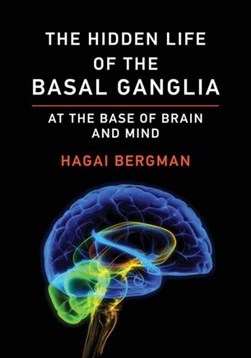-
BROWSE 1000s OF BOOKS IN STOCK
-
FREE DELIVERY ON ORDERS OVER €10
-
PRE-ORDER OBSESSED BY JOHNNY SEXTON
The hidden life of the basal ganglia
PAPERBACK
The main task of the basal ganglia-a group of subcortical nuclei, located at the base of the brain-is to optimise and execute our automatic behaviour. In this book, Hagai Bergman analyses the anatomy and physiology of the basal ganglia, discussing their relation to brain and behaviour, to disorders and therapies, and even to moral values. Drawing on his forty years of studying the basal ganglia, Bergman presents new information on physiology and computational models, Parkinson's disease and other ganglia-related disorders, and such therapies as deep brain stimulation. Focusing on studies of nonhuman primates and human basal ganglia and relying on system physiology and in vivo extra-cellular recording techniques, Bergman first describes the major brain structures that constitute the basal ganglia, the morphology of their cellular elements, their synaptic connectivity and their physiological function in health and disease. He discusses the computational physiology of the healthy basal ganglia, describing four generations of computational models, and then traces the computational physiology of basal ganglia-related disorders and their treatments, including Parkinson's disease and its pharmacological and surgical therapies. Finally, Bergman considers the implications of these findings for such moral concerns as free will. Explaining this leap into domains rarely explored in neuroscientific accounts, Bergman writes that the longer he studies the basal ganglia, the more he is convinced that they are truly the base of both brain and mind.
€69.60

208 Reward Points
In stock online
Extended Range: Delivery in 2-3 working days
Extended Range: Delivery in 2-3 working days
Free Delivery on this item
Any purchases for more than €10 are eligible for free delivery anywhere in the UK or Ireland!
The main task of the basal ganglia-a group of subcortical nuclei, located at the base of the brain-is to optimise and execute our automatic behaviour. In this book, Hagai Bergman analyses the anatomy and physiology of the basal ganglia, discussing their relation to brain and behaviour, to disorders and therapies, and even to moral values. Drawing on his forty years of studying the basal ganglia, Bergman presents new information on physiology and computational models, Parkinson's disease and other ganglia-related disorders, and such therapies as deep brain stimulation. Focusing on studies of nonhuman primates and human basal ganglia and relying on system physiology and in vivo extra-cellular recording techniques, Bergman first describes the major brain structures that constitute the basal ganglia, the morphology of their cellular elements, their synaptic connectivity and their physiological function in health and disease. He discusses the computational physiology of the healthy basal ganglia, describing four generations of computational models, and then traces the computational physiology of basal ganglia-related disorders and their treatments, including Parkinson's disease and its pharmacological and surgical therapies. Finally, Bergman considers the implications of these findings for such moral concerns as free will. Explaining this leap into domains rarely explored in neuroscientific accounts, Bergman writes that the longer he studies the basal ganglia, the more he is convinced that they are truly the base of both brain and mind.

208 Reward Points
Any purchases for more than €10 are eligible for free delivery anywhere in the UK or Ireland!
€69.60

208 Reward Points
Any purchases for more than €10 are eligible for free delivery anywhere in the UK or Ireland!
Product Description
The main task of the basal ganglia-a group of subcortical nuclei, located at the base of the brain-is to optimise and execute our automatic behaviour. In this book, Hagai Bergman analyses the anatomy and physiology of the basal ganglia, discussing their relation to brain and behaviour, to disorders and therapies, and even to moral values. Drawing on his forty years of studying the basal ganglia, Bergman presents new information on physiology and computational models, Parkinson's disease and other ganglia-related disorders, and such therapies as deep brain stimulation. Focusing on studies of nonhuman primates and human basal ganglia and relying on system physiology and in vivo extra-cellular recording techniques, Bergman first describes the major brain structures that constitute the basal ganglia, the morphology of their cellular elements, their synaptic connectivity and their physiological function in health and disease. He discusses the computational physiology of the healthy basal ganglia, describing four generations of computational models, and then traces the computational physiology of basal ganglia-related disorders and their treatments, including Parkinson's disease and its pharmacological and surgical therapies. Finally, Bergman considers the implications of these findings for such moral concerns as free will. Explaining this leap into domains rarely explored in neuroscientific accounts, Bergman writes that the longer he studies the basal ganglia, the more he is convinced that they are truly the base of both brain and mind.
Product Details
ISBN9780262543118
FormatPAPERBACK
PublisherTHE MIT PRESS (08 October. 2021)
No. of Pages288
Weight710
Language English
Dimensions 254 x 178 x 25

